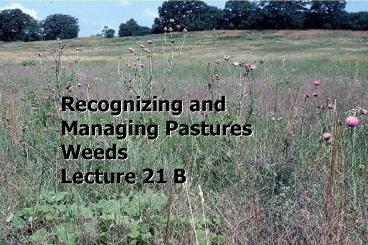Pasture Weed Management - PowerPoint PPT Presentation
1 / 30
Title:
Pasture Weed Management
Description:
grows in patches; male and female. flowers on separate heads & plants. Spotted Knapweed. Another biennial (or short-lived perennial) Loves sandy soil ... – PowerPoint PPT presentation
Number of Views:172
Avg rating:3.0/5.0
Title: Pasture Weed Management
1
Recognizing and Managing Pastures Weeds Lecture
21 B
2
Good Management Gives 90of Your Pasture Weed
Control
_________
Controlled grazing - clipping
Preventative measures
Dense stand Proper fertility
3
Common Weeds in Pastures
- Annuals
- Ragweeds
- Smartweeds
- Yellow foxtail
- Biennials
- Bull thistle
- Plumeless thistle
- Musk thistle
- Burdock
- Wild parsnip
- Perennials
- Canada thistle
- Goldenrod
- Curly dock
- Horsenettle
- Chicory
- Brush
- Willows
- Box elder
- Multiflora rose
- Prickly ash
4
Thistle Identification
5
Thistle Biology
- They vary in life cycle
- Annuals ___________________
- Biennials bull, musk and plumeless
- Perennials Canada and perennial sowthistle
6
Bull Thistle
- leaves deeply cut, witha wrinkled,
gray-greensurface - Midvein of leaves
- often whitishspines needle-like
7
Bull Thistle
- stem appears spiny
- decurrent leaves(run down along stem)
8
Bull Thistle
- inflorescence flask-shaped
9
Musk Thistle
- leaves smooth, withgray-green margin andwhite,
hairless midrib - No hairs on either side of the leaf
10
Musk Thistle
- stem spiny exceptbelow flower head
- inflorescence1.5 to 2" across
11
Plumeless Thistle
- leaves deeply divided
- leaves hairy esp. lowersurface midrib
- leaf lobes often at anangle to midrib
12
Plumeless Thistle
- stems spiny from base to tip
- inflorescence .75 to 1.5" wide
13
Canada Thistle
- leaves spiny withcrinkled, spiny edges
- roots deep and branched
14
Canada Thistle
- flowers pink-purple flaskshaped, 3/4 inch wide
- grows in patches male and femaleflowers on
separate heads plants
15
Spotted Knapweed
- Another biennial (or short-lived perennial)
- Loves sandy soil
- Prolific seed producer
- Inhibits growth of other plants
16
Spotted Knapweed
- Leaves and stemsare coarse and rough textured
- Flowerheads pretty
- Bracts are blackenedon tips thus the
namespotted knapweed
17
Burdock ________________
18
Biennial Weed Management
- Key to long-term
- control is
- ________________
19
When to Treat Biennials?
- Best results when treated in seedling or rosette
stages - this is any time in the year of germination
- and up to bolting stage in second year
- After bolting, ___________is best option
- They can also be controlled by cutting just below
the soil surface.
20
When to Treat Biennials?
- ___________ applications ideal
- all plants of concern in rosette stage
- active translocation to crown/roots
- less hectic time of year
21
What to Use for Biennials?
- Growth regulator herbicides all effective
- 2,4-D, dicamba (Clarity/Banvel), Stinger and
others - Several premixes available
- WeedMaster 2,4-D dicamba
- Crossbow 2,4-D Garlon
- Glyphosate (Roundup and company) may fit in some
situations
22
Glyphosate in Spot Applications
- Use with caution Glyphosate _____________________
_____________ - Appropriate for small infestations
- Use backpack sprayer with single nozzle
- No need to treat entire plant aim for the
rosette center
23
Glyphosate in Selective Applicators
- Effective on weeds taller than forages
- Safe to shorter grasses and legumes
- May not kill thistles but usually prevents seed
production
24
When to Treat Canada Thistle(and other
herbaceous perennials)
- Best timing is in ______________________stage
- Stinger Effective on Canada thistle but
expensive - Dicamba (Clarity/Banvel) alone or with 2,4-D
more economical but less effective long-term
25
Yellow Foxtail
Flattened stem
26
Yellow Foxtail
27
Yellow Foxtail Biology
- An annual grass that spreads/increases annually
- A true opportunistic weed
- Why so common in some pastures?
- Over grazing?
- Poor pasture stands/mixes
- Heavy grazing followed by rain event?
- Hot, wet periods?
- Low nitrogen levels?
28
Yellow Foxtail Control in Pasture
- Prevention the best medicine
- Clipping helps but impossible to prevent all seed
production - Plateau now labeled for pastures
- Claims yellow foxtail control at 4 oz/a
- Timing important and challenging
29
For All Treatments in Pastures
- Take inventory on weed regrowth or species
changes - the season applied
- and several times annually thereafter
30
Get it All Together
Chemical
Mechanical
INTEGRATED (Diversified)
Cultural































